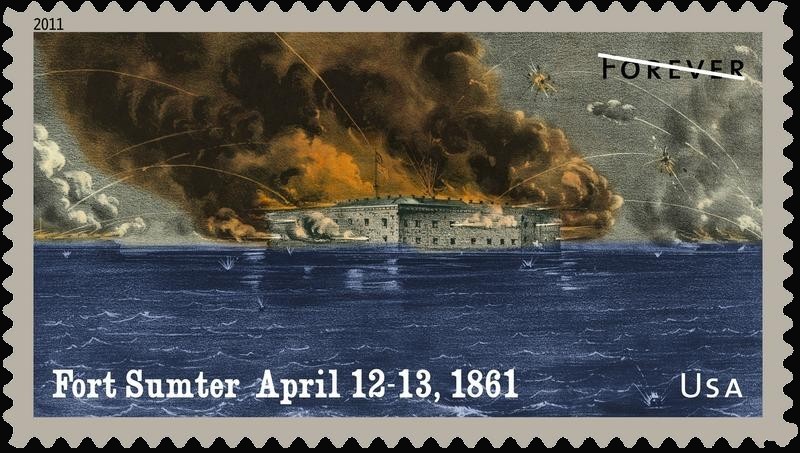Fort Sumter – The War Begins
Posted By Norman Gasbarro on April 12, 2011
Fifty years ago, I was eagerly awaiting the release of the first of five United States stamp issues to recognize the Centennial of the Civil War. A green four cent stamp was to be issued in Charleston, South Carolina, at Fort Sumter where the first shots were fired. I was a junior in high school at the time, and taking the required first-year course in American history, which covered the years from the age of discovery to the end of the Civil War and Reconstruction. In April, we were still studying the causes of the war and efforts to compromise on the slavery issue. It was exciting to me that my first venture into a formal study of the Civil War coincided with the anniversary of its beginning.
My stamp collection was very small then, consisting only of single unused copies of the stamps I could afford to buy at the post office. But for some reason, I decided to do more in collecting this new set of stamps.
A friend told me about “First Day Covers” and how you could send a self-addressed envelope to the postmaster at Charleston, along with the pennies to pay for the four cent stamp, and you would receive in return an envelope with a special “first day of issue cancellation” that would be both a souvenir and an investment. I also learned that stamp collector shops, such as the one at Wanamakers in Philadelphia, sold “cacheted” envelopes that were specifically designed for each stamp issue, and that for a few pennies, I could buy one or more of those “cacheted” envelopes and use those instead of or in addition to the blank ones I planned to send to Charleston. The “cachets” were commercially printed designs on the left side of the envelope that related to the stamp issue. And so, about a week before the scheduled date for the issue of the stamp, I shipped twelve envelopes along with four dimes, a nickel and three pennies to the Charleston postmaster.
In those days, new stamps first went on sale in one city on the day of issue. The second day, they were released nationwide. I would have to wait another day to buy the stamps at my local post office – which I did. The stamps were beautiful! They were designed by Charles R. Chickering. A few days later, the first day covers began to arrive. The Fort Sumter stamp thus became the foundation of what would become an expanded, specialized collection of United States stamps.
The Civil War Centennial lasted into my junior year of college. The collection continued to grow and for each of the new issues in the Civil War series, I prepared the self-addressed envelopes and mailed them to the postmaster in the first day city. The “Rifleman at the Battle of Shiloh” was issued on 7 April 1962 at Shiloh, Tennessee. The “Blue and Gray at Gettysburg” was issued on 1 July 1863 at Gettysburg, Pennsylvania. The “Battle of the Wilderness” was issued on 5 May 1964 at Fredericksburg, Virginia. And, finally, “Appomattox” was issued on 9 April 1865, at Appomattox, Virginia.
The “investment” part of collecting these stamps was bad advice. It turns out that nearly 603,000 envelopes were canceled at Charleston with the “First Day of Issue” cancellation, hardly a “limited edition.” and the total number of these four cent stamps that were issued exceeded 100,000,000. But the interest that was sparked in me toward history and my continued study of the Civil War was an unexpected dividend. I majored in history in college. I taught history for many years. And now, I’m enjoying researching and writing about the Civil War while chairing the Civil War Research Project.
The United States Postal Service has announced stamp issues to celebrate 150th anniversary the beginning of the Civil War and naturally, there is a stamp for Fort Sumter. I won’t be sending off envelopes this time to get the first day cancel because a few years ago I sold my whole collection.
It is doubtful that anyone with a connection to the Lykens Valley or the Civil War Research Project was present at Fort Sumter when it was fired upon and when the war officially began. But surely the news appeared in the local newspapers. A previous post entitled New Years Day 1861 presented some diagrams of the fort and dismissed the value of the fort in the overall Southern effort – a few Union ships could blockade the harbor and make the fort useless if the fort were lost. By April, the situation had changed, and as a matter of honor, when the fort was fired upon and the U.S. flag hauled down, the war began.
The 2011 Fort Sumter stamp photo is from the USPS website.
 ;
;





Comments